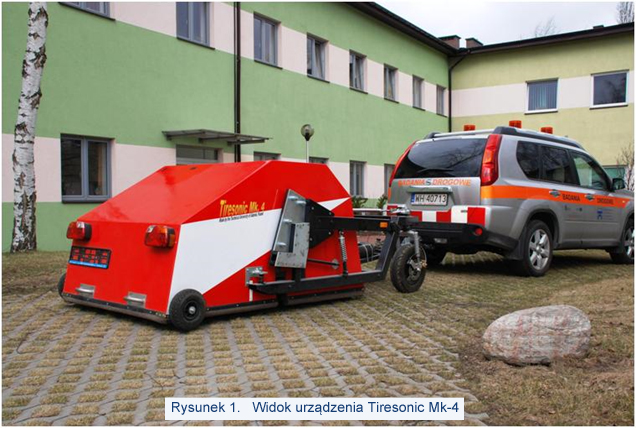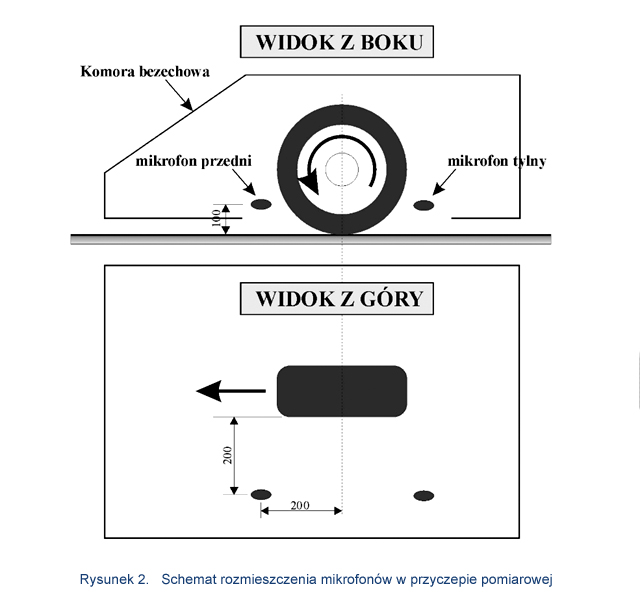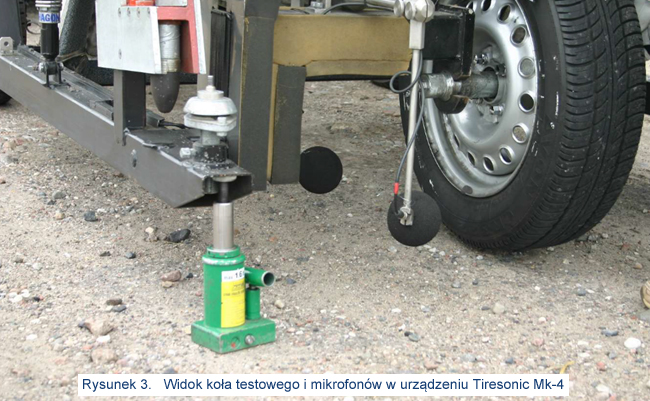Tiresonic Mk-4 pavement noise measurement system for CPX method
Noise measurements of pavements using the CPX(Close Proximity Method, EN ISO 11819-2:2017-06 - Acoustics - Measurement of the effect of road pavements on road noise - Part 2: Near-field measurement method) are made with a Tiresonic Mk-4 device (Fig. 1).

Figure 1. View of the Tiresonic Mk-4 device
The CPX method is mainly used to evaluate different road pavement technologies in terms of their impact on traffic noise, under conditions of predominant tire-pavement contact noise. The interpretation of the results relates to the free movement of a vehicle travelling on an essentially level road at a constant speed of more than 40 km/h, in which case the predominance of noise generated at the tire-pavement contact is assumed. The CPX method is applicable in the following cases, among others:
-
in the evaluation of pavement noise, the main purpose of which is to check compliance with the pavement construction specifications,
-
to check acoustic durability, such as under the influence of wear and tear, pavement damage, “clogging” of voids, and in assessing the effectiveness of cleaning porous pavements,
-
to check the uniformity of a road section,
-
development of quieter road pavements and study of tire-pavement contact.
In the CPX method, A-filter-weighted averaged sound levels recorded over a test section, at a specified speed, are measured by at least two microphones placed close to the tires. The tests use a special test vehicle that is self-propelled or is towed behind another vehicle. The reference tires are mounted on the test vehicle, either individually or two at a time.
Tests are performed to determine the level of CPX (LCPX) recorded by the microphones, at one or more reference speeds. This can be achieved by performing tests at a reference speed or by normalizing speed deviations.
For each reference tire and each individual test run with that tire, average LCPX levels are recorded over short test segments (sections of 10 meters each), along with the corresponding vehicle speeds. The LCPX of each segment is normalized to the reference speed using a simple correction procedure. Averaging is then carried out according to the purpose of the measurement, i.e. measuring a specific segment or a certain number of consecutive segments (section).
CPX level (LCPX: t vref) is the resulting average level for the two mandatory microphones at the reference speed, vref for the reference tire t, where t is P or H (depending on the tire used). If CPX levels were determined for both reference tires, LCPX index: And it is the average LCPX: P and LCPX: H with equal weight given to both levels.
The design of the Tiresonic Mk-4 test vehicle ensures that noise measurements can be carried out under conditions similar to those of the benchmark - that is, without the involvement of noise sources other than the tire rolling on the road pavement and without sound wave reflections from surfaces other than the road pavement. The sound recording microphones are effectively isolated from external factors by an anechoic shield (chamber). During testing, two microphones are placed in the positions defined in Figure 2.

Figure 2. Diagram of microphone placement in the measuring trailer
The test wheel, microphones and thermometers are placed on the measuring trailer. Tests are conducted at the nominal speeds specified in ISO 11819-2. The following nominal speeds are preferred: 50, 80 and 110 km/h. The actual speed of the test vehicle should be measured during each test run. Based on these measurements, the average speed is determined for each 10-m test segment and then the results of the noise level measurements are corrected against the nominal speed.
Standard CPX tests should be conducted using the reference tires described in ISO 11819-3. Depending on the purpose of the tests, either the P tire (for passenger cars) or the H tire (for trucks) is used. A view of the test wheel, installed on the trailer, and the microphones prepared for noise measurements is shown in Figure 3.
Figure 3. View of the test wheel and microphones in the Tiresonic Mk-4 device

 EN
EN  PL
PL  DE
DE  FR
FR  IT
IT  ES
ES  CS
CS  SV-SE
SV-SE  DA
DA  NL
NL  HU
HU  RO
RO  UA
UA 


